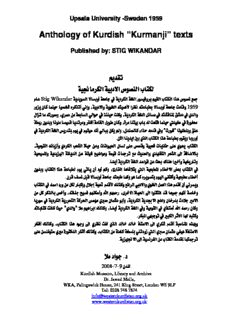
Anthology of Kurdish “Kurmanji” texts PDF
Preview Anthology of Kurdish “Kurmanji” texts
Upsala University -Sweden 1959 Anthology of Kurdish “Kurmanji” texts Published by: STIG WIKANDAR @@@âî‡Õm @@óï−bà‹ÙÜa@óïi†ýa@™í—åÜa@lbnÙÜ Stig Wikandar @ãbÈ@ @óî‡îíÜa@ýbiìc@óÉàbu@À@óÙÜa@óÍÝÜa@ŠíïÐì‹i@âïÕÜa@lbnÙÜa@a‰è@™í—ä@Ê» 1959 @Šìî@çbØ@báåïy@bï—ƒ’@ë‹Ø‰mc@ðägì@Lóïi†ýaì@óîíÍÝÜa@ênïáèÿ@a‹Åä@ênÈbji@ýbiìc@óÉàbu@oàbÔì@ @ßam@bà@êmŠí–ì@Lñ‹áÈ@æà@óÉibÜa@ðÜaíy@À@‰øåïy@oåØì@LóÙÜa@óÍÝÜa@Þ÷bà@À@ên“Ôbå¾@Ö“à†@À@ñ‡Üaì @óiŠ@çì‡iì@bäíÝà@b—ïáÔ@bî‡m‹àì@‹Õ’c@óàbÕÜa@Þîí @çbØì@Lò‹à@bånïi@lbi@êÜ@oznÐ@báåïy@Ýï¬@À@òŠíÑ« @À@óÙÜa@óÍÝÜa@ni@ãíî@À@ãíÕï@êäc@ðÜbji@æÙî@ì@L߇å—ÜbØ@öa‰y@êà‡Ô@Àì@BpŠí’B@bäíÝåiì@ÖåÈ @@@Nçła@båî‡îa@μi@ñ‰Üa@lbnÙÜa@a‰è@óÈbji@ãíÕîì@biìŠìc @LóïàíÕÜa@ê÷bîŒcì@ñ†‹ÙÜa@kÉ“Üa@òbïy@æÈì@pbäaíï¨a@çbÜ@ôÝÈ@˜—Ôì@óïjÉ’@pbîbÙy@ôÝÈ@ñí±@lbnÙÜa @óïzï¾aì@óî‡îïÜa@óäbî‡Üa@æÈ@óÕï’@Êïšaíàì@óáïÔ@pb»‹m@Êà@saì@ñ‡ïÝÕnÜa@‹É“Üa@¶a@óÐbšýbi @@Nb›îc@óÙÜa@óÍÝÜa@‡ÈaíÔ@æÈ@s¢@Ûbåè@a‚cì@óﲊbmì @çì‡iì@lbnÙÜa@a‰è@óÈbjÜ@ãíî@ðmdî@çc@†ìc@âØì@LúŠbÕÜa@bèbÐþnî@Üa@óïÉj¾a@öb‚ýa@Éi@lbnÙÜa@À @@Nç‹Ô@Ò—ä@ÞjÔ@ýbiìc@óÉàbu@ênÉj @báØì@íè@báØ@ë‹îí—ni@ãíïÜa@ðÑnØcì@óïÉjà@öb‚c @lbnÙÜa@À@êa@†Šì@æà@ÞÙÜ@ŠbjØgì@ßþug@óï¥@ã‡Ôÿ@Ú܉Øì@Ê÷a‹Üa@ði†ýaì@ñíÍÝÜa@ÞáÉÜa@a‰è@ã‡Ôc@çc@ðä‹îì @æà@ÞØ@‹Ø‰Übi@˜‚cì@Lêmbåu@|ïÐ@âéåÙcì@a@â鼊@Lõ‹‚ýa@òbï¨a@¶a@aíÝÕnäa@‡Ô@bÉï»@âéäc@ó–b‚ì @bîŠí@À@óÙÜa@óznÜa@óØ‹¨a@üà@ñ–@çbárÈ@íieì@LóÙÜa@óýa@Êšaì@çb‚Š‡i@p†þu@àýa @êmbibnØ@oäbØ@sïy@Bñ‡ÜaìB@þà@âïèa‹ia@Ú܉Øì@Lb›îc@óÙÜa@óÍÝÜa@Àì@óïàíÕÜa@À@ñˆbnc@a@꼊@çbØì @@N‹Ùj¾a@ðéjuím@À@jÙÜa@‹qýa@b@êjnØì @‹Ù’c@Ú܉Øì@LlbnÙÜa@a‰è@†íuì@¶a@ñ‹Åä@oÑÜ@ñ‰Üa@‡Üb‚@‡Üb‚@ˆbnýa@¶a@ñ‹Ù’@ã‡Ôc@ójbå¾a@ë‰éiì @ôÝÈ@æåÑïn@ñà@òŠín؇Üa@‹Ù’c@Ú܉Øì@LlbnÙÜa@æà@óÝàbØ@óƒåi@m†ìŒ@Üa@ñ–@çbárÈ@ðÑïè@òˆbnýa @@NóîïÝ−ýa@¶a@óïä‹ÑÜa@æà@lbnÙÜa@óà‡Õ¾@bén»‹m @@ þà@†aíu@N†@ 2008 7 9 M M @ç‡åÜ@ Kurdish Museum, Library and Archive Dr. Jawad Mella, WKA, Palingswick House, 241 King Street, London W6 9LP Tel: 0208 748 7874 [email protected] www.westernkurdistan.org.uk Foreword The aim of this anthology is to provide a fuller picture of the Kurdish dialect than any of the texts published hitherto. In 1931 the brothers Celadet and Kamuran Bedirxan invented a Latin script on the model of the new Turkish script for the form of western Kurdish they called kurmanci or kurdmanci. This term is also used here to designate the literary language based on the Boti dialect which seems destined to play an important role in the intellectual life of the Kurdish people. It has already experienced considerable growth, in particular between 1932 and 1945. The purpose of this anthology is to present this language in all its forms. It includes examples of folktales and poetry, but also ethnographic and historical articles and extracts from grammatical authorities. The texts in section seven, ‘Grammar’, give readers a good overview of the grammatical structure of Kurdish whilst the translations of extracts from world literature that make up section six will help readers to familiarise themselves as much with Kurdish vocabulary as with grammar. Most of the texts are drawn from publications that have appeared in Syria or Lebanon and are difficult for a western readership to access. The anthology also includes unpublished texts. Where no source is given but only an author the texts were dictated to me in 1953 in Damascus or Qubur al-Bid. Osman Sebri’s remarkable study of Kurdish spelling and phonology (no. 37) is published from a manuscript kindly made available to me by the author. Uppsala, October 1958. 1. Fables and anecdotes 2. Folktales 3. Life and customs of the Kurdish people 4. Traditional poetry 5. Modern poetry 6. Translations 7. Grammar The heading is in Swedish Book titles are normally left in the original language. Many thanks to Dr. Mary Stevens translated this foreword from French, the origin text, into English. http://www.westernkurdistan.org.uk/documents/StigWikander.pdf @@
Description: